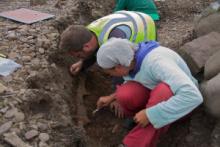The Ardnamurchan Transition Project is an ongoing effort by a teachm of Scottish archaeologists to explore and record finds along the Ardnamurchan peninsula in a remote area of Scotland. Their highest profile find yet is that of a 1,000 year-old intact burial site of a high-status Viking, most likely a lord or “chieftan”. The man was uncovered in a 5-meter long grave that was inside his Viking ship, which was also buried. With him were found an intricately carved sword, a shield boss (the circular metal piece in the center of a shield), a spear, ax, and bronze cloak pin. Also found with him was a knife, the bronze tip of a drinking horn, a whetstone from Norway, and pottery fragments from Ireland and elsewhere. The finds seems to support that he was a high-ranking Viking, buried with his weapons and with items from a number of places through the British Isles and Scandinavian Peninsulas. Given the items contained in the grave, and the style of burial, the man was most likely of Norse origin, and likely had not been a landed lord but a true Viking; attacks and pillaging across the coastlines and retreating back to the sea. Many Vikings at this time actually invaded Britain, taking over the fortresses and lands of local nobles from Scotland to northern England (then called Northumbria).
The Ardnamurchan Transition project will continue to guarantee funding from British, Scottish, and Irish sources as they ramp up their work in the Peninsula. Finds have gone back much further than this spectacular Viking find, all the way back to 4,500-6,000 years ago among Neolithic herders and farmers.
